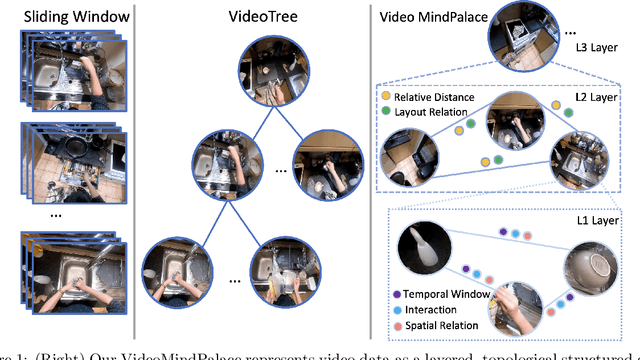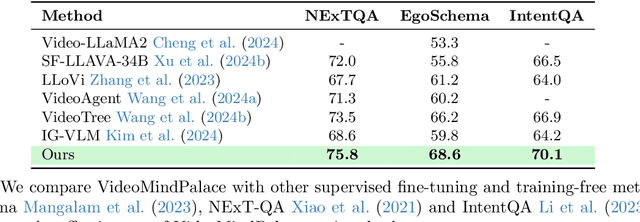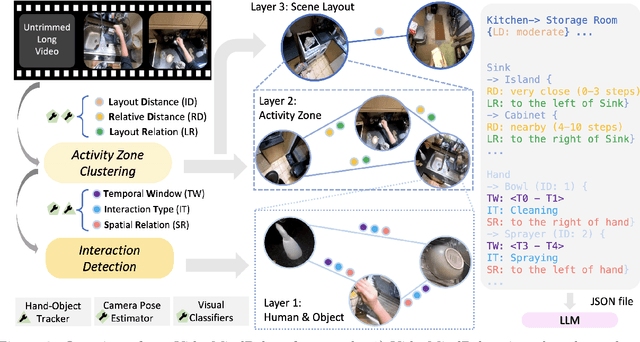Zeyi Huang
MultiCrafter: High-Fidelity Multi-Subject Generation via Spatially Disentangled Attention and Identity-Aware Reinforcement Learning
Sep 26, 2025Abstract:Multi-subject image generation aims to synthesize user-provided subjects in a single image while preserving subject fidelity, ensuring prompt consistency, and aligning with human aesthetic preferences. However, existing methods, particularly those built on the In-Context-Learning paradigm, are limited by their reliance on simple reconstruction-based objectives, leading to both severe attribute leakage that compromises subject fidelity and failing to align with nuanced human preferences. To address this, we propose MultiCrafter, a framework that ensures high-fidelity, preference-aligned generation. First, we find that the root cause of attribute leakage is a significant entanglement of attention between different subjects during the generation process. Therefore, we introduce explicit positional supervision to explicitly separate attention regions for each subject, effectively mitigating attribute leakage. To enable the model to accurately plan the attention region of different subjects in diverse scenarios, we employ a Mixture-of-Experts architecture to enhance the model's capacity, allowing different experts to focus on different scenarios. Finally, we design a novel online reinforcement learning framework to align the model with human preferences, featuring a scoring mechanism to accurately assess multi-subject fidelity and a more stable training strategy tailored for the MoE architecture. Experiments validate that our framework significantly improves subject fidelity while aligning with human preferences better.
VisualToolAgent (VisTA): A Reinforcement Learning Framework for Visual Tool Selection
May 26, 2025Abstract:We introduce VisTA, a new reinforcement learning framework that empowers visual agents to dynamically explore, select, and combine tools from a diverse library based on empirical performance. Existing methods for tool-augmented reasoning either rely on training-free prompting or large-scale fine-tuning; both lack active tool exploration and typically assume limited tool diversity, and fine-tuning methods additionally demand extensive human supervision. In contrast, VisTA leverages end-to-end reinforcement learning to iteratively refine sophisticated, query-specific tool selection strategies, using task outcomes as feedback signals. Through Group Relative Policy Optimization (GRPO), our framework enables an agent to autonomously discover effective tool-selection pathways without requiring explicit reasoning supervision. Experiments on the ChartQA, Geometry3K, and BlindTest benchmarks demonstrate that VisTA achieves substantial performance gains over training-free baselines, especially on out-of-distribution examples. These results highlight VisTA's ability to enhance generalization, adaptively utilize diverse tools, and pave the way for flexible, experience-driven visual reasoning systems.
T2I-ConBench: Text-to-Image Benchmark for Continual Post-training
May 22, 2025Abstract:Continual post-training adapts a single text-to-image diffusion model to learn new tasks without incurring the cost of separate models, but naive post-training causes forgetting of pretrained knowledge and undermines zero-shot compositionality. We observe that the absence of a standardized evaluation protocol hampers related research for continual post-training. To address this, we introduce T2I-ConBench, a unified benchmark for continual post-training of text-to-image models. T2I-ConBench focuses on two practical scenarios, item customization and domain enhancement, and analyzes four dimensions: (1) retention of generality, (2) target-task performance, (3) catastrophic forgetting, and (4) cross-task generalization. It combines automated metrics, human-preference modeling, and vision-language QA for comprehensive assessment. We benchmark ten representative methods across three realistic task sequences and find that no approach excels on all fronts. Even joint "oracle" training does not succeed for every task, and cross-task generalization remains unsolved. We release all datasets, code, and evaluation tools to accelerate research in continual post-training for text-to-image models.
Talk is Not Always Cheap: Promoting Wireless Sensing Models with Text Prompts
Apr 22, 2025Abstract:Wireless signal-based human sensing technologies, such as WiFi, millimeter-wave (mmWave) radar, and Radio Frequency Identification (RFID), enable the detection and interpretation of human presence, posture, and activities, thereby providing critical support for applications in public security, healthcare, and smart environments. These technologies exhibit notable advantages due to their non-contact operation and environmental adaptability; however, existing systems often fail to leverage the textual information inherent in datasets. To address this, we propose an innovative text-enhanced wireless sensing framework, WiTalk, that seamlessly integrates semantic knowledge through three hierarchical prompt strategies-label-only, brief description, and detailed action description-without requiring architectural modifications or incurring additional data costs. We rigorously validate this framework across three public benchmark datasets: XRF55 for human action recognition (HAR), and WiFiTAL and XRFV2 for WiFi temporal action localization (TAL). Experimental results demonstrate significant performance improvements: on XRF55, accuracy for WiFi, RFID, and mmWave increases by 3.9%, 2.59%, and 0.46%, respectively; on WiFiTAL, the average performance of WiFiTAD improves by 4.98%; and on XRFV2, the mean average precision gains across various methods range from 4.02% to 13.68%. Our codes have been included in https://github.com/yangzhenkui/WiTalk.
HoGS: Unified Near and Far Object Reconstruction via Homogeneous Gaussian Splatting
Mar 25, 2025Abstract:Novel view synthesis has demonstrated impressive progress recently, with 3D Gaussian splatting (3DGS) offering efficient training time and photorealistic real-time rendering. However, reliance on Cartesian coordinates limits 3DGS's performance on distant objects, which is important for reconstructing unbounded outdoor environments. We found that, despite its ultimate simplicity, using homogeneous coordinates, a concept on the projective geometry, for the 3DGS pipeline remarkably improves the rendering accuracies of distant objects. We therefore propose Homogeneous Gaussian Splatting (HoGS) incorporating homogeneous coordinates into the 3DGS framework, providing a unified representation for enhancing near and distant objects. HoGS effectively manages both expansive spatial positions and scales particularly in outdoor unbounded environments by adopting projective geometry principles. Experiments show that HoGS significantly enhances accuracy in reconstructing distant objects while maintaining high-quality rendering of nearby objects, along with fast training speed and real-time rendering capability. Our implementations are available on our project page https://kh129.github.io/hogs/.
Do Vision Models Develop Human-Like Progressive Difficulty Understanding?
Mar 17, 2025Abstract:When a human undertakes a test, their responses likely follow a pattern: if they answered an easy question $(2 \times 3)$ incorrectly, they would likely answer a more difficult one $(2 \times 3 \times 4)$ incorrectly; and if they answered a difficult question correctly, they would likely answer the easy one correctly. Anything else hints at memorization. Do current visual recognition models exhibit a similarly structured learning capacity? In this work, we consider the task of image classification and study if those models' responses follow that pattern. Since real images aren't labeled with difficulty, we first create a dataset of 100 categories, 10 attributes, and 3 difficulty levels using recent generative models: for each category (e.g., dog) and attribute (e.g., occlusion), we generate images of increasing difficulty (e.g., a dog without occlusion, a dog only partly visible). We find that most of the models do in fact behave similarly to the aforementioned pattern around 80-90% of the time. Using this property, we then explore a new way to evaluate those models. Instead of testing the model on every possible test image, we create an adaptive test akin to GRE, in which the model's performance on the current round of images determines the test images in the next round. This allows the model to skip over questions too easy/hard for itself, and helps us get its overall performance in fewer steps.
IMPROVE: Iterative Model Pipeline Refinement and Optimization Leveraging LLM Agents
Feb 25, 2025



Abstract:Computer vision is a critical component in a wide range of real-world applications, including plant monitoring in agriculture and handwriting classification in digital systems. However, developing high-performance computer vision models traditionally demands both machine learning (ML) expertise and domain-specific knowledge, making the process costly, labor-intensive, and inaccessible to many. Large language model (LLM) agents have emerged as a promising solution to automate this workflow, but most existing methods share a common limitation: they attempt to optimize entire pipelines in a single step before evaluation, making it difficult to attribute improvements to specific changes. This lack of granularity leads to unstable optimization and slower convergence, limiting their effectiveness. To address this, we introduce Iterative Refinement, a novel strategy for LLM-driven ML pipeline design inspired by how human ML experts iteratively refine models, focusing on one component at a time rather than making sweeping changes all at once. By systematically updating individual components based on real training feedback, Iterative Refinement improves stability, interpretability, and overall model performance. We implement this strategy in IMPROVE, an end-to-end LLM agent framework for automating and optimizing object classification pipelines. Through extensive evaluations across datasets of varying sizes and domains, including standard benchmarks and Kaggle competition datasets, we demonstrate that Iterative Refinement enables IMPROVE to consistently achieve better performance over existing zero-shot LLM-based approaches. These findings establish Iterative Refinement as an effective new strategy for LLM-driven ML automation and position IMPROVE as an accessible solution for building high-quality computer vision models without requiring ML expertise.
Building a Mind Palace: Structuring Environment-Grounded Semantic Graphs for Effective Long Video Analysis with LLMs
Jan 08, 2025



Abstract:Long-form video understanding with Large Vision Language Models is challenged by the need to analyze temporally dispersed yet spatially concentrated key moments within limited context windows. In this work, we introduce VideoMindPalace, a new framework inspired by the "Mind Palace", which organizes critical video moments into a topologically structured semantic graph. VideoMindPalace organizes key information through (i) hand-object tracking and interaction, (ii) clustered activity zones representing specific areas of recurring activities, and (iii) environment layout mapping, allowing natural language parsing by LLMs to provide grounded insights on spatio-temporal and 3D context. In addition, we propose the Video MindPalace Benchmark (VMB), to assess human-like reasoning, including spatial localization, temporal reasoning, and layout-aware sequential understanding. Evaluated on VMB and established video QA datasets, including EgoSchema, NExT-QA, IntentQA, and the Active Memories Benchmark, VideoMindPalace demonstrates notable gains in spatio-temporal coherence and human-aligned reasoning, advancing long-form video analysis capabilities in VLMs.
Unleashing In-context Learning of Autoregressive Models for Few-shot Image Manipulation
Dec 03, 2024



Abstract:Text-guided image manipulation has experienced notable advancement in recent years. In order to mitigate linguistic ambiguity, few-shot learning with visual examples has been applied for instructions that are underrepresented in the training set, or difficult to describe purely in language. However, learning from visual prompts requires strong reasoning capability, which diffusion models are struggling with. To address this issue, we introduce a novel multi-modal autoregressive model, dubbed $\textbf{InstaManip}$, that can $\textbf{insta}$ntly learn a new image $\textbf{manip}$ulation operation from textual and visual guidance via in-context learning, and apply it to new query images. Specifically, we propose an innovative group self-attention mechanism to break down the in-context learning process into two separate stages -- learning and applying, which simplifies the complex problem into two easier tasks. We also introduce a relation regularization method to further disentangle image transformation features from irrelevant contents in exemplar images. Extensive experiments suggest that our method surpasses previous few-shot image manipulation models by a notable margin ($\geq$19% in human evaluation). We also find our model can be further boosted by increasing the number or diversity of exemplar images.
Ascend HiFloat8 Format for Deep Learning
Sep 26, 2024



Abstract:This preliminary white paper proposes a novel 8-bit floating-point data format HiFloat8 (abbreviated as HiF8) for deep learning. HiF8 features tapered precision. For normal value encoding, it provides 7 exponent values with 3-bit mantissa, 8 exponent values with 2-bit mantissa, and 16 exponent values with 1-bit mantissa. For denormal value encoding, it extends the dynamic range by 7 extra powers of 2, from 31 to 38 binades (notice that FP16 covers 40 binades). Meanwhile, HiF8 encodes all the special values except that positive zero and negative zero are represented by only one bit-pattern. Thanks to the better balance between precision and dynamic range, HiF8 can be simultaneously used in both forward and backward passes of AI training. In this paper, we will describe the definition and rounding methods of HiF8, as well as the tentative training and inference solutions. To demonstrate the efficacy of HiF8, massive simulation results on various neural networks, including traditional neural networks and large language models (LLMs), will also be presented.
 Add to Chrome
Add to Chrome Add to Firefox
Add to Firefox Add to Edge
Add to Edge